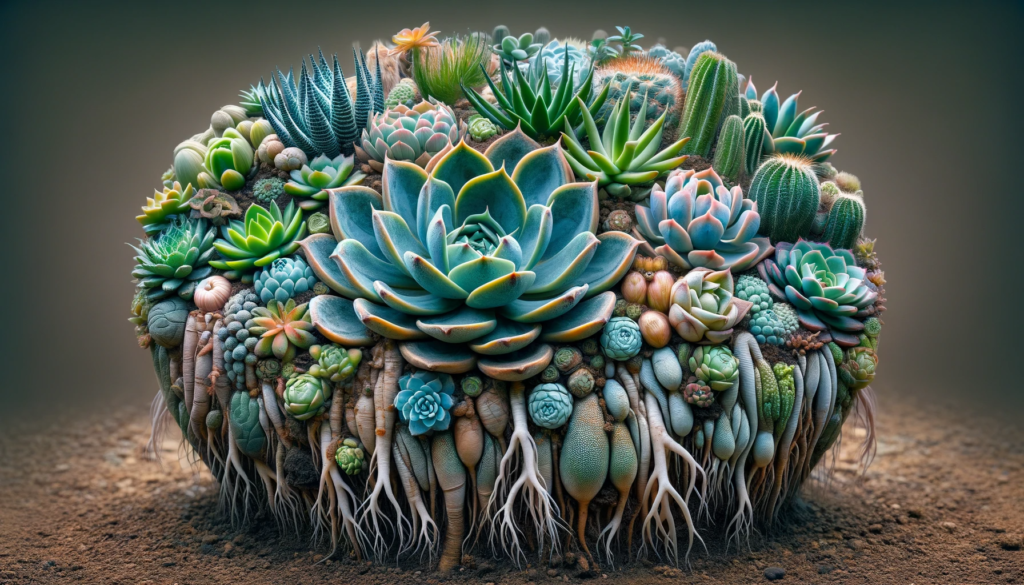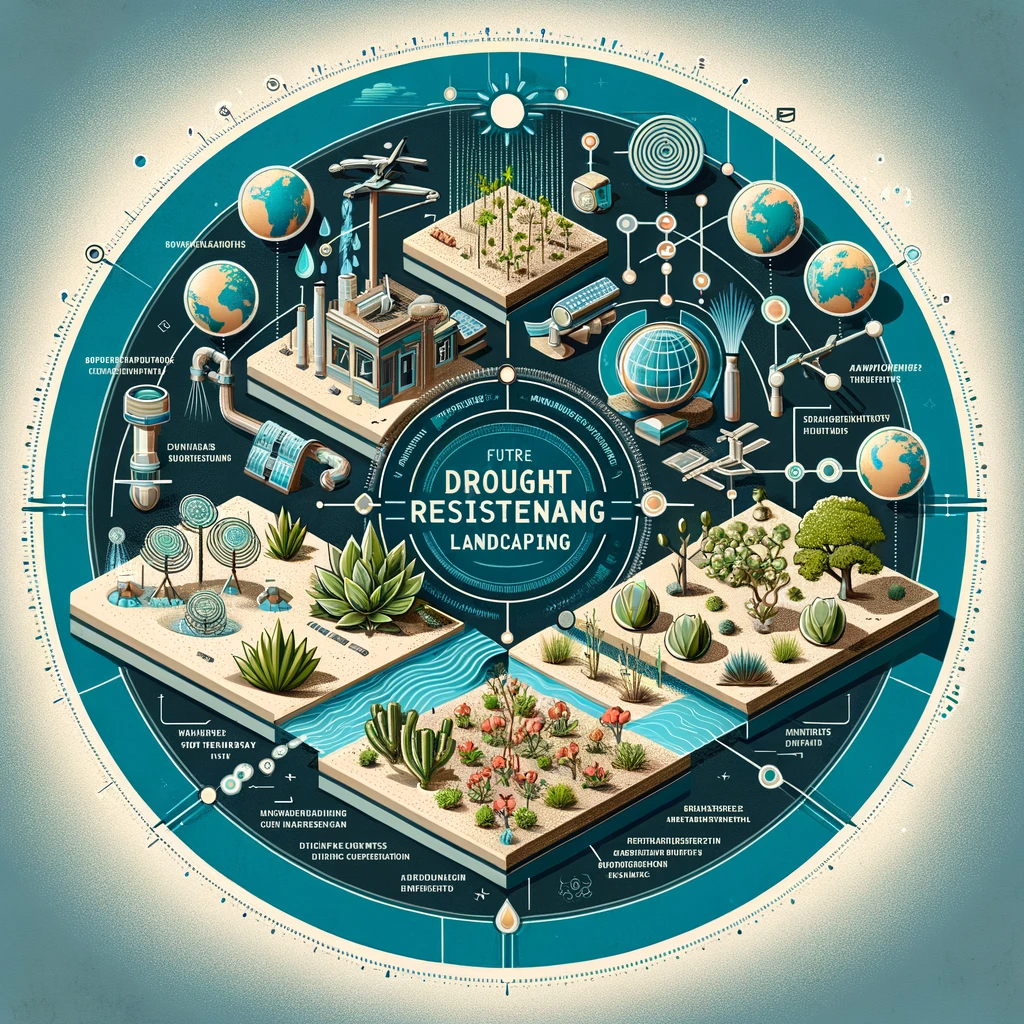In an era where water conservation is no longer optional but imperative, drought-resistant plants are becoming the heroes of sustainable landscaping. With water scarcity affecting over two billion people worldwide, the need for low-water gardens is not just a trend but a necessity. Drought-resistant plants offer a practical solution, thriving in dry conditions while adding vibrance to your garden.
Key Takeaways:
- Water Conservation: Reduces the need for excessive irrigation, saving precious water resources.
- Low Maintenance: Requires less watering, mowing, and fertilizing, saving time and resources.
- Environmental Sustainability: Supports biodiversity and alleviates strain on freshwater sources.
- Cost-Effective: Leads to long-term savings on water bills and lawn care products.
- Aesthetic Diversity: Offers a variety of plants with unique textures, colors, and forms.
Explore more about sustainable landscaping practices on our Drought Tolerant Landscaping Blog.
Understanding Drought Resistant Plants

What Makes a Plant Drought Resistant
Drought-resistant plants have evolved various mechanisms to survive in dry conditions. Many have deep tap roots, reaching for moisture deep in the soil, while others feature succulent leaves or waxy coatings that minimize water loss. These plants are nature’s answer to thriving in arid environments.
The Importance in Modern Landscaping
Incorporating drought-resistant plants into landscaping isn’t just a stylistic choice; it’s an environmental imperative. They play a crucial role in sustainable gardening, reducing the reliance on water and helping landscapes adapt to changing climate conditions.
Discover the diverse range of drought-resistant plants available through our Landscaping Services.
The Science Behind Drought Resistance
Plant Adaptations for Water Conservation
Drought-resistant plants are nature’s marvels, equipped with specialized adaptations to conserve water. For instance, succulents store water in their fleshy leaves, while others have evolved thick root structures like bulbs and corms to retain moisture.
Root Systems of Drought Tolerant Plants
The root systems of these plants are designed to maximize water uptake. Deep tap roots can access water from deeper soil layers, ensuring survival during dry spells.
Top Drought Resistant Plants for Your Garden
Succulents and Their Unique Traits
Succulents, with their moisture-retaining qualities, are a fantastic choice for drought-tolerant landscapes. Their plump leaves store water, allowing them to remain hydrated and vibrant even in dry conditions.
Top Succulents for Dry Climates:
- Aloe Vera: Known for its medicinal properties.
- Agave: Offers striking forms perfect for focal points.
- Sedum: Ideal for ground covers with their diverse colors.
Popular Drought-Resistant Flowering Plants
Several flowering plants also exhibit drought resistance. Aster, for example, produces beautiful daisy-like flowers and adapts well to various conditions.
Drought-Resistant Flowering Plants:
- Aster (Symphyotrichum spp.): Produces daisy-like flowers in various hues.
- Beardtongue (Penstemon spp.): Attracts pollinators with its colorful tubular flowers.
For more on drought-resistant flowering plants, visit our Blog on Drought-Resistant Shrubs.
Incorporating Native Plants for Sustainability
Benefits of Native Drought-Resistant Plants
Native plants are exceptionally adapted to local climates, including drought conditions. They play a crucial role in sustaining local ecosystems and often require less water than non-native species.
Identifying Local Drought-Resistant Species
Observe plants in your neighborhood that thrive during dry spells; they are indicators of drought-resistant species suitable for your area.
Identifying Drought-Resistant Plants:
- Observe neighborhood plants during dry spells.
- Research native plants and their adaptability to drought.
Learn more about adapting your garden to local conditions on our Category Blog for Drought Tolerant Landscaping.
Creating a Drought-Resistant Landscape

Design Principles for Water-Efficient Gardens
Drought-tolerant landscaping is not just about selecting the right plants; it’s also about designing with water efficiency in mind. This includes using plants like Blanket Flower and Blue Fescue that require minimal water and are visually stunning.
Design Tips for Water-Efficient Gardens:
- Group plants with similar water needs.
- Use rocks and pebbles for landscaping to reduce soil moisture loss.
Combining Aesthetics and Sustainability
A thoughtfully designed drought-resistant landscape can be both environmentally sustainable and visually attractive. Incorporating diverse plants like Bugleweed and Catmint can add color, texture, and interest while conserving water.
Aesthetic and Sustainable Plants:
- Bugleweed (Ajuga reptans): Offers attractive foliage and flowers.
- Catmint (Nepeta spp.): Known for its long-blooming blue, white, or pink flowers.
For more landscaping tips, check out our Landscaping Tips Blog.
Soil Management for Drought-Resistant Gardening
Enhancing Soil to Support Drought Tolerance
To create a successful drought-resistant garden, begin by improving the soil. Mixing compost into the soil at planting time enhances its moisture retention capacity.
Soil Enhancement Strategies:
- Mix lots of compost into the soil.
- Use organic matter to improve soil structure.
The Role of Compost and Mulch
Compost is not only beneficial for soil health but also for water conservation. Additionally, applying a 2- to 3-inch layer of organic mulch around plants can prevent moisture from evaporating directly from the soil surface and reduce weed growth.
Benefits of Mulching:
- Retains soil moisture.
- Reduces weed growth.
Learn about the dos and don’ts of landscaping, including soil management, on our Do’s and Don’ts of Landscaping Blog.
The Beauty of Drought-Resistant Flowers
Long-Blooming Drought-Resistant Flowers
Many drought-resistant plants are not only functional but also beautiful. For example, the Black-eyed Susan and Blanket Flower are known for their long blooming seasons and vibrant colors, adding aesthetic value to water-wise gardens.
Long-Blooming Varieties:
- Black-eyed Susan (Rudbeckia spp.): Offers rich gold, bronze, and brown flowers.
- Blanket Flower (Gaillardia spp.): Known for its bright red, orange, and yellow flowers.
Colorful Options for Dry Climates
Drought-resistant flowering plants like Beardtongue and Cranesbill Geranium offer a range of colors, from vivid blues and purples to bright yellows and oranges, ensuring that dry gardens can be as colorful as any other.
Colorful Drought-Resistant Plants:
- Beardtongue (Penstemon spp.): Features a variety of colors in its flowers.
- Cranesbill Geranium (Geranium spp.): Offers versatility in color and form.
For innovative ideas to beautify your garden, visit our California Turf Removal Rebate Program Blog.
Drought-Tolerant Trees and Shrubs
Large Plants for Water-Wise Landscapes
Integrating trees and shrubs into a drought-tolerant landscape adds structure and height. Plants like Lantana and Lavender, which are larger and bushier, are excellent for creating focal points in a dry garden.
Trees and Shrubs for Drought-Resistant Landscapes:
- Lantana (Lantana camara): Offers vibrant, butterfly-attracting flowers.
- Lavender (Lavandula spp.): Known for its fragrant and visually stunning flowers.
Trees and Shrubs for Dry Conditions
Even in dry conditions, there are trees and shrubs that thrive. For example, Moss Rose and Pinks are excellent choices for adding both beauty and resilience to water-wise landscapes.
Resilient Plant Choices:
- Moss Rose (Portulaca spp.): Thrives in heat and drought.
- Pinks (Dianthus spp.): Adaptable to naturally dry conditions.
For an extensive guide on drought-resistant shrubs, explore our Blog on Drought-Resistant Shrubs.
Rock Gardens and Drought-Resistant Plants
Designing a Rock Garden with Minimal Water Needs
Rock gardens are a perfect match for drought-tolerant plants. They offer a unique aesthetic while reducing water usage. Plants like Hen and Chicks and Stonecrop are ideal for rock gardens due to their ability to thrive in well-draining soil and their interesting textures.
Rock Garden Favorites:
- Hen and Chicks (Sempervivum tectorum): Known for its rosette-forming clumps.
- Stonecrop (Sedum spp.): Offers a variety of sizes, forms, and colors.
Best Plants for Rock Gardens
Select plants that naturally grow in rocky or sandy environments. Sedum and Wormwood are excellent choices for rock gardens as they require minimal water and can thrive in challenging conditions.
Ideal Rock Garden Plants:
- Sedum: A drought-tolerant succulent with star-shaped flowers.
- Wormwood (Artemisia spp.): Offers aromatic silvery foliage.
For more insights into creating beautiful rock gardens, visit our Blog on Drought Tolerant Landscaping.
Ground Covers for Dry Areas
Low-Maintenance, Water-Efficient Ground Covers
Incorporating ground covers like Sedum and Wormwood in drought-tolerant gardens can offer both aesthetic appeal and practical benefits. These plants form dense mats that cover the soil, reducing water evaporation and weed growth.
Effective Ground Covers:
- Sedum: Provides living mulch to suppress weeds.
- Wormwood: Suitable for hot and dry sites.
Ground Covers That Thrive with Minimal Water
Choose ground covers that are adaptable to dry conditions. Plants like Moss Rose and Pinks not only add color but also thrive with minimal water, making them ideal for drought-resistant landscaping.
Drought-Resistant Ground Covers:
- Moss Rose: Tolerant of heat, drought, and poor soil.
- Pinks: Well adapted to alpine and rocky regions.
Discover more about efficient ground covers on our Drought Tolerant Landscaping Tips Blog.
The Wonders of Succulent Gardens
Types of Succulents for Dry Climates
Succulents are a standout choice for drought-resistant gardens. Their water-storing capabilities make them perfect for dry climates. Varieties like Hen and Chicks and Blue Fescue offer interesting textures and forms for your garden.
Popular Succulents for Dry Gardens:
- Hen and Chicks (Sempervivum tectorum): Offers mat-forming clumps of rosettes.
- Blue Fescue (Festuca glauca): Known for its blue-green foliage.
Designing a Succulent Landscape
Create a visually striking landscape with a variety of succulents. Their unique shapes and colors can transform a garden space into an artistic, drought-resistant haven.
Design Elements for Succulent Gardens:
- Variety in color and form.
- Use of rocks and gravel for enhancing texture.
For more succulent garden designs, visit our Blog on Drought Tolerant Landscaping.
Perennials That Resist Drought
Hardy Perennials for Dry Gardens
Drought-resistant perennials like Purple Coneflower and Russian Sage are hardy choices for dry gardens. They offer long-lasting blooms and require minimal maintenance, making them a practical addition to any drought-tolerant landscape.
Hardy Drought-Resistant Perennials:
- Purple Coneflower (Echinacea purpurea): Attracts butterflies and pollinators.
- Russian Sage (Perovskia atriplicifolia): Known for its spiky blue flowers.
Perennials with Minimal Water Needs
Select perennials that are known for their drought tolerance. Plants like Sage and Spurge can provide color and texture to your garden while requiring very little water.
Low-Water Perennials:
- Sage / Salvia (Salvia spp.): Attracts bees, butterflies, and hummingbirds.
- Spurge (Euphorbia spp.): Features exotic flower bracts and foliage.
For detailed perennial plant guides, explore our Landscaping Tips Blog.
Herbs That Tolerate Dry Conditions
Culinary and Medicinal Herbs for Drought Conditions
Drought-resistant herbs like Lavender and Rosemary are not only aromatic but also thrive in dry conditions. They can be used in culinary creations while adding beauty to your garden.
Drought-Resistant Herbs:
- Lavender (Lavandula spp.): Offers fragrant flowers and foliage.
- Rosemary (Rosmarinus officinalis): Ideal for use as a shrub or ground cover.
Planting and Caring for Drought-Resistant Herbs
When planting herbs in a drought-resistant garden, ensure they are placed in well-draining soil and receive enough sunlight. Regular pruning and harvesting can encourage healthier growth and better yield.
Tips for Growing Drought-Resistant Herbs:
- Ensure adequate sunlight.
- Regular pruning for healthier plants.
Discover more about growing and caring for herbs in dry conditions on our Blog on Landscaping Tips.
Drought-Resistant Landscaping Techniques
Effective Watering Strategies
Optimize your watering routine by doing it early in the morning or late in the evening to reduce evaporation. Deep watering is preferable as it encourages deeper root growth.
Watering Tips for Drought-Resistant Gardens:
- Water early in the morning or late evening.
- Prefer deep watering to shallow, frequent watering.
Mulching for Moisture Conservation
Applying a layer of organic mulch around your plants can help retain soil moisture and suppress weed growth, reducing the need for frequent watering.
Benefits of Mulching:
- Retains soil moisture.
- Reduces weed growth.
Learn effective mulching techniques on our Do’s and Don’ts of Landscaping Blog.
Cost-Effective Drought-Resistant Gardening
Long-Term Financial Benefits
While the initial investment in drought-resistant plants may be higher, the long-term savings in water bills and reduced need for lawn care products make it a financially sound choice.
Budget-Friendly Drought-Resistant Plant Options
Many drought-resistant plants are available at reasonable prices. Choosing native and local varieties can further reduce costs while ensuring garden success.
Find out more about cost-effective gardening solutions on our California Turf Removal Rebate Program Blog.
Attracting Wildlife with Drought-Resistant Plants
Plants That Attract Pollinators and Birds
Many drought-resistant plants are attractive to wildlife such as bees, butterflies, and birds. Plants like Beardtongue and Black-eyed Susan are particularly known for attracting pollinators.
Wildlife-Friendly Plants:
- Beardtongue: A magnet for bees and butterflies.
- Black-eyed Susan: Attracts a variety of pollinators and birds.
Creating a Wildlife-Friendly Dry Garden
By incorporating a variety of drought-resistant plants, your garden can become a haven for local wildlife, contributing to biodiversity and ecological balance.
Tips for a Wildlife-Friendly Garden:
- Choose plants that provide nectar and pollen.
- Include plants that offer shelter and nesting spots.
For more about creating wildlife-friendly gardens, visit our Drought Tolerant Landscaping Blog.
Overcoming Challenges in Drought-Resistant Gardening
Addressing Common Misconceptions
There’s a misconception that drought-resistant landscapes lack beauty. However, with thoughtful design and plant selection, they can be as visually appealing as any lush garden.
Challenging Misconceptions:
- Educate on the beauty of drought-resistant plants.
- Showcase the diversity of drought-resistant landscaping.
Solutions to Common Challenges
Educating others about the benefits and possibilities of drought-tolerant landscaping can help overcome resistance and encourage wider adoption of these practices.
Overcoming Gardening Challenges:
- Provide resources and education.
- Share success stories and case studies.
Learn more about tackling gardening challenges on our Blog on Drought Tolerant Landscaping.
The Future of Drought-Resistant Landscaping

Trends and Innovations in Dry Climate Gardening
The field of drought-resistant landscaping is continuously evolving, with new trends and innovations helping gardens thrive even in the driest conditions.
The Role of Drought-Resistant Plants in Climate Change Adaptation
As climate change intensifies, drought-resistant plants are becoming an essential part of adapting our landscapes to new environmental realities.
Stay updated with the latest trends in drought-resistant landscaping on our Blog on Landscaping Tips.
Community and Urban Applications
Drought-Resistant Plants in Public Spaces
Utilizing drought-resistant plants in public spaces can significantly reduce municipal water usage and maintenance costs while providing aesthetically pleasing environments.
Educating Communities on Water-Wise Gardening
Community education programs can play a vital role in spreading awareness about the benefits of drought-resistant plants and sustainable gardening practices.
Join our community discussions on sustainable urban landscaping on our Drought Tolerant Landscaping Category Blog.
Further Insights
For more information on drought-resistant plants and sustainable landscaping, visit:
- The Bloom UP for insights on water-conserving houseplants.
- The Old Farmer’s Almanac for tips on creating a drought-tolerant garden.
- Garden Design for a list of drought-tolerant plants and landscaping ideas.
